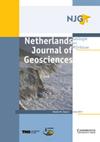Geothermal play typing in Germany, case study Molasse Basin: a modern concept to categorise geothermal resources related to crustal permeability
IF 2.3
2区 地球科学
Q3 GEOSCIENCES, MULTIDISCIPLINARY
Netherlands Journal of Geosciences-Geologie En Mijnbouw
Pub Date : 2020-02-18
DOI:10.1017/njg.2019.12
引用次数: 16
Abstract
Abstract The majority of running geothermal plants worldwide are located in geological settings with convection- or advection-dominant heat transport. In Germany as in most regions in Europe, conduction is the dominating heat transport mechanism, with a resulting average geothermal gradient. The geothermal play type concept is a modern methodology to group geothermal resources according to their geological setting, and characteristic heat transport mechanisms. In particular, the quantity of heat transport is related to fluid flow in natural or engineered geothermal reservoirs. Hence, the permeability structure is a key element for geothermal play typing. Following the existing geothermal play type catalogue, four major geothermal play types can be identified for Germany: intracratonic basins, foreland basins and basement/crystalline rock provinces as conduction-dominated play types, and extensional terrains as the convection-dominated play type. The installed capacity of geothermal facilities sums up to 397.1 MWth by the end of 2018. District heating plants accounted for the largest portion, with about 337.0 MWth. The majority of these installations are located in the play type ‘foreland basin’, namely the Molasse Basin in southern Germany. The stratigraphic unit for geothermal use is the Upper Jurassic, also known as ‘Malm’ formation, a carbonate reservoir with high variability in porosity and permeability. Recently drilled wells in the southernmost Molasse Basin indicate the Upper Jurassic as a tight, fracture-controlled reservoir, not usable for conventional hydrothermal well doublets. Our new data compilation including the recently drilled deep geothermal well Geretsried reveals the relation of porosity and permeability to depth. The results suggest that obviously diagenetic processes control permeability with depth in carbonate rock, diminishing the predictability of reservoir porosity and permeability. The play type concept helps to delineate these property variations in play type levels because it is based on geological constraints, common for exploration geology. Following the general idea of play typing, the results from this play analysis can be transferred to geological analogues as carbonate rock play levels in varying depth.德国地热油气藏类型,以Molasse盆地为例:一种与地壳渗透率相关的地热资源分类的现代概念
世界上大多数正在运行的地热发电厂都位于以对流或平流为主的热输送地质环境中。在德国和欧洲大多数地区一样,传导是主要的热传输机制,因此产生平均地热梯度。地热油气藏类型概念是根据地热资源的地质背景和热输运机制特征对地热资源进行分组的一种现代方法。特别是,热输运量与天然或工程地热储层中的流体流动有关。因此,渗透率结构是地热油气藏分型的关键因素。根据现有地热储层类型目录,德国地热储层类型主要有克拉通内盆地、前陆盆地和基底/结晶岩省为传导型储层类型,伸展地型为对流型储层类型。截至2018年底,全国地热设施装机容量达397.1兆瓦。区域供热厂占最大比例,约为337.0 mth。这些设施中的大多数位于“前陆盆地”,即德国南部的Molasse盆地。地热利用的地层单元是上侏罗统,也被称为“马尔姆”地层,这是一种孔隙度和渗透率高度变化的碳酸盐岩储层。最近在Molasse盆地最南端钻探的井表明,上侏罗统是一个致密的、裂缝控制的储层,不能用于常规的热液双井。我们的新数据汇编包括最近钻探的深地热井Geretsried,揭示了孔隙度和渗透率与深度的关系。结果表明,碳酸盐岩成岩作用对渗透率具有明显的深度控制作用,降低了储层孔隙度和渗透率的可预测性。储层类型概念有助于描述储层类型水平上的这些属性变化,因为它基于地质约束,这在勘探地质学中很常见。根据储层类型的一般思路,储层分析的结果可以转化为不同深度的碳酸盐岩储层的地质类似物。
本文章由计算机程序翻译,如有差异,请以英文原文为准。
求助全文
约1分钟内获得全文
求助全文
来源期刊
CiteScore
4.00
自引率
25.90%
发文量
14
审稿时长
>12 weeks
期刊介绍:
Netherlands Journal of Geosciences - Geologie en Mijnbouw is a fully open access journal which publishes papers on all aspects of geoscience, providing they are of international interest and quality. As the official publication of the ''Netherlands Journal of Geosciences'' Foundation the journal publishes new and significant research in geosciences with a regional focus on the Netherlands, the North Sea region and relevant adjacent areas. A wide range of topics within the geosciences are covered in the journal, including "geology, physical geography, geophyics, (geo-)archeology, paleontology, hydro(geo)logy, hydrocarbon exploration, modelling and visualisation."
The journal is a continuation of Geologie and Mijnbouw (published by the Royal Geological and Mining Society of the Netherlands, KNGMG) and Mededelingen Nederlands Instituut voor Toegepaste Geowetenschappen (published by TNO Geological Survey of the Netherlands). The journal is published in full colour.

 求助内容:
求助内容: 应助结果提醒方式:
应助结果提醒方式:


